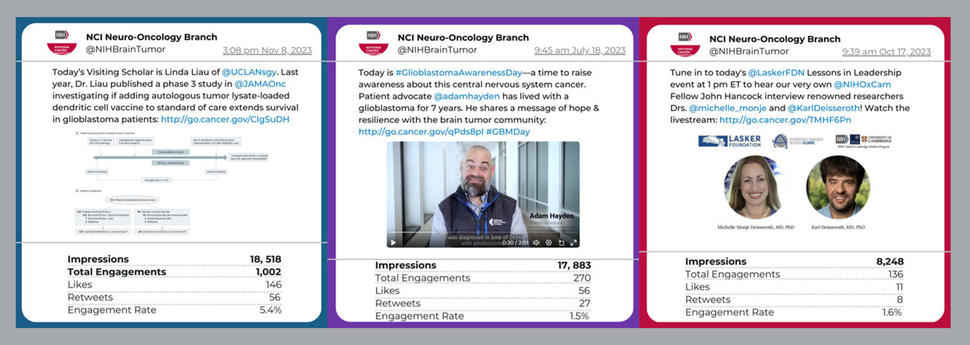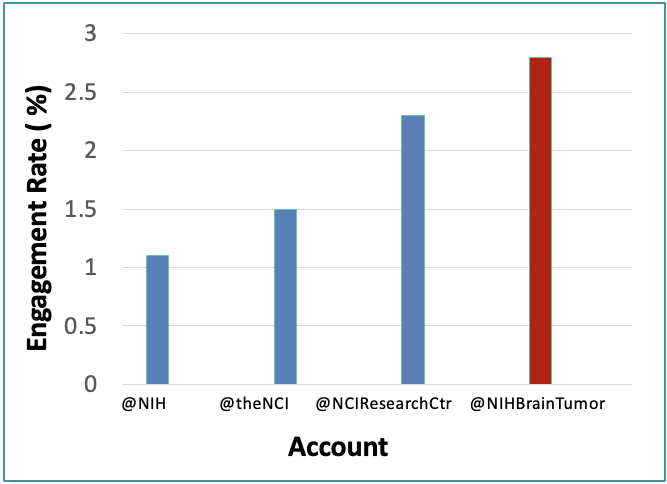Using Social Media to Educate and Engage the Brain and Spine Tumor Community
, by Rebecca Zacuto, Neuro-Oncology Branch Communications Fellow
A data analysis shows the value of the @NIHBrainTumor X (formerly Twitter) account as a resource for patients, caregivers, and advocates, as well as neuro-oncology providers and researchers.
Social media is a popular mode for sharing scientific content with the public. X (formerly Twitter) has long been a beloved platform among scientists and academics. Dubbed the “discourse app,” X lends itself to sharing ideas and information in bite-sized (280-character) snippets.
In 2016, the NCI Center for Cancer Research’s Neuro-Oncology Branch (NOB) created an X account called @NIHBrainTumor. It is the only public-facing social media account for the NOB and its Cancer Moonshotsm-funded program, NCI-CONNECT.
@NIHBrainTumor aims to meet a previously unmet need by sharing content about central nervous system (CNS) cancers, which represent less than 2 percent of cancers diagnosed each year in the United States. The content includes educational information, support resources, clinical care, research, and treatment advances. It is tailored to the NOB and NCI-CONNECT audience base: people with CNS cancers, caregivers, advocates, neuro-oncology providers, and researchers.
Recently, X has undergone significant changes. These include decreasing content moderation and introducing a “For You” tab that shows content curated by an algorithm. A team of communication specialists, led by NOB Communications Fellow Rebecca Zacuto, recently conducted data analyses to understand how these changes have affected @NIHBrainTumor’s performance and audience engagement.
“The CNS tumor community is small because these tumors are so rare,” Zacuto explains. “Our X account provides tailored content for this community and fills a niche. We share resources and information that otherwise may not be widely available.”
In August 2023, the team began by creating an in-depth calendar to track the X content they published. In February 2024, Zacuto began utilizing analytics.twitter.com—which automatically captures X data—to track metrics from January 2022 to January 2024. Zacuto also conducted a literature review to determine how the scientific community at large has been impacted by changes to the platform. Lastly, the team collaborated with social media managers within NIH to glean insights into how other government X accounts are performing.
Zacuto focused on the three metrics that provided the richest insight: impressions, engagements, and engagement rate.
Impressions are the total number of times a post has been seen. Between August 2022 and January 2024, @NIHBrainTumor’s posts received a total of 2.4 million impressions. Generally, more impressions mean more visibility for the account. They can also help social media managers understand if the X algorithm favors specific posts and determine the type of posts that perform the best.
Zacuto identified the top posts as those that received the largest number of impressions. Posts about scientific publications, awareness holidays (such as Glioblastoma Awareness Day and Brain Tumor Awareness Month), special events, and videos topped the list. A wide range of topics consistently received lots of impressions, including glioblastoma, metabolism research, meningioma, cancer statistics, survivorship, and patient resources.
Engagements represent the total number of times a user interacts with a post. This includes likes, replies, retweets, mentions, link clicks, media views, and more. Engagement rate—the number of engagements divided by the number of impressions—is considered the best indicator for the success of an X account. @NIHBrainTumor had an engagement rate of 2.8 percent, which was higher than similar accounts including @NIH (NIH), @theNCI (National Cancer Institute), and @NCIResearchCtr (Center for Cancer Research).
“This finding excited me,” Zacuto says. “Our strong engagement rate shows that we produce content that reaches and resonates with our key audiences. A smaller community brings the opportunity to create more specific content, which in turn positively impacts our engagement rate.”
As of June 27, 2024, @NIHBrainTumor had 7,811 followers. It averages about 1,080 new followers each year. Ultimately, the team concluded that—despite X’s recent changes—the @NIHBrainTumor account persists as a valuable resource for its key audiences because it provides the brain and spine tumor community with unique, clear, accurate, and curated content.
“The content can help people with these rare tumors understand their diagnosis, make decisions about their care, and improve their quality of life,” Zacuto says. “To me, that is the most rewarding part of our social media account.”


